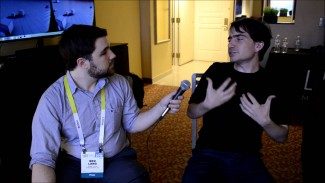Leap Motion formed prior to the VR craze, but it turns out that their goal of allowing you to use your own hands as a way to interact with computers jived quite nicely with virtual reality. In recent years the company has made a major pivot toward VR and it culminates today with ‘Orion’, an overhauled hand tracking engine built from the ground up for VR.
When Leap Motion first dreamed up their gesture tracking device, the intended use case was that the unit would sit on a desk facing upward and detect a user’s hands as they held them above the device, using it to control activity on a computer monitor.
Fast forward a few years and the company says they are “100% focused on VR”, moving the major use-case to a head mounted gesture tracking device which of course sees hands from a different angle entirely (and has a tracking space that’s dependent on where the user is looking).
The company says that Orion, their new made-for-VR hand tracking engine, has been in the works for at least a year and that the engine is a major improvement, calling it “radically smoother, faster, more reliable, and far more capable than even the best of what’s existed before.” The company summaries some of the improvements:
- Orion starts tracking faster, and keeps tracking farther, with lower latency, and in situations where no previous software could keep up.
- Unprecedented sensitivity allows us to maintain reliable hand tracking even in high angle, high occlusion scenarios.
- Incredible progress has also been made in separating the hand out from cluttered backgrounds, allowing you to bring your hand close to or even in contact with other surfaces. This advance has also improved performance in all lighting conditions, making it extremely difficult to find an environment where you won’t have high precision hand tracking.
The Orion engine can be experienced on the company’s existing hand tracking camera (which they call ‘The Peripheral’) through a beta release of the software made available today at the Leap Motion developer portal.

Orion also sets the stage for a new sensor that the company says will be embedded in VR headset this year. The tiny commodity chip is easy to build into such devices, though the company maintains, “99% of the value comes in the [hand-tracking] software.”
Last month at CES, we got to preview the company’s new ‘interaction engine’ which was designed to enhance user interaction within the virtual world. The interaction engine sought to improve understanding of user intent, leading to more consistent actions like grabbing, releasing, and throwing objects. We were impressed by the improvements it brought to the table and fortunately Leap Motion says that Orion will have the same capabilities, along with a number of other performance enhancements.







